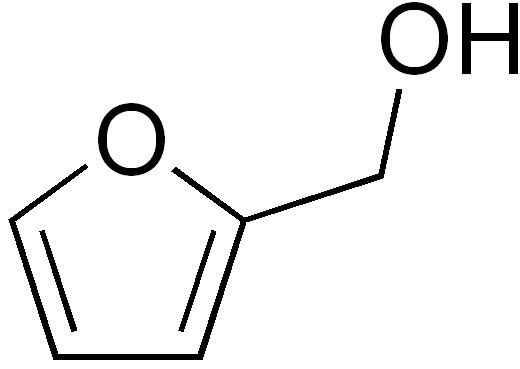Formula C5H6O2 Molar mass 98.1 g/mol | Boiling point 170 °C Density 1.13 g/cm³ | |
 | ||
Appearance colorless to amber liquid | ||
Furfuryl alcohol, also called 2-furylmethanol or 2-furancarbinol, is an organic compound containing a furan substituted with a hydroxymethyl group. It is a clear colorless liquid when pure, but becomes amber colored upon prolonged standing. It possesses a faint odor of burning and a bitter taste. It is miscible with but unstable in water. It is soluble in common organic solvents. Upon treatment with acids, heat and/or catalysts, furfuryl alcohol can be made to polymerize into a resin, poly(furfuryl alcohol).
Contents
Synthesis
Furfuryl alcohol is manufactured industrially from furfural; which is itself typically produced from waste bio-mass such as corncobs or sugar cane bagasse. As such furfuryl alcohol may be considered a green chemical. It is produced either by the direct reduction of furfural, or by its disproportionation via the Cannizaro reaction in an aqueous NaOH solution; this latter route also produces furoic acid.
Plastics
The primary use of furfuryl alcohol is as a monomer for the synthesis of furan resins. These are used in thermoset polymer matrix composites, cements, adhesives, coatings and casting/foundry resins. Synthesis involves acid-catalyzed polycondensation, usually giving a black cross-linked product. A simplified example is shown below but the actual reaction mechanism is known to be exceedingly complex.
Other uses
Furfuryl alcohol has been used in rocketry as a fuel which ignites hypergolically (immediately and energetically in contact) with white fuming nitric acid or red fuming nitric acid oxidizer. The use of hypergolics avoids the need for an igniter. In late 2012, Spectra, a concept liquid rocket engine using white fuming nitric acid as the oxidizer to furfuryl alcohol fuel was static tested by Copenhagen Suborbitals.
Because of its low molecular weight, furfuryl alcohol can impregnate the cells of wood, where it can be polymerized and bonded with the wood by heat, radiation, and/or catalysts or additional reactants. The treated wood has improved moisture-dimensional stability, hardness, and decay and insect resistance; catalysts can include zinc chloride, citric or formic acid, or borates.
